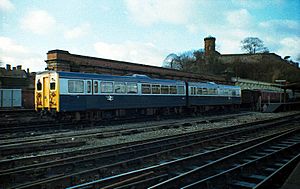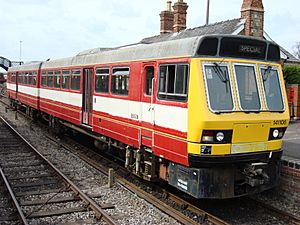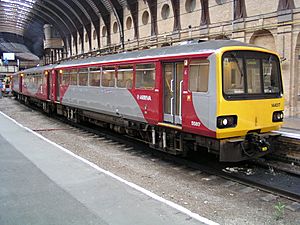Pacer facts for kids
Quick facts for kids Pacer |
|
|---|---|
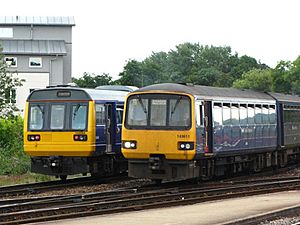
|
|
| In service | 1984– present (production units) |
| Family name | Pacer |
| Constructed | 1980–1987 |
| Number built | 165 sets |
| Number in service | 15 sets (National Rail) |
| Number scrapped | 37 sets (142/143/144) |
| Operator(s) | Great Western Railway
Transport for Wales Regional Railways Arriva Trains Northern Arriva Trains Wales Arriva Rail North Northern Rail Northern Trains Valley Lines Wales & Borders Wessex Trains Islamic Republic of Iran Railways (1997–2005) |
| Specifications | |
| Track gauge | 4 ft 8 1⁄2 in (1,435 mm) standard gauge |
Pacer trains are a special type of train called railbuses. They were built in Britain between 1980 and 1987. There are several types, known as classes: 140, 141, 142, 143, and 144.
These trains are diesel multiple units. This means each carriage has its own diesel engine. Pacers were built quickly because British Rail didn't have enough regular trains. They were only meant to be used for about 20 years. However, they ended up being used for nearly 35 years!
Most Pacer trains stopped being used in 2020. Two main reasons led to this. First, it was hard for people with disabilities to get onto Pacer trains. Rules say all public trains must be easy for disabled people to use by 2020. Only one Pacer, the 144e, met this rule.
Second, the government decided in 2015 to stop using Pacers. They felt these "uncomfortable and low-quality vehicles" were bad for the economy.
At the start of 2020, 138 Pacer trains were still running. They were used by Northern Trains, Great Western Railway, and Transport for Wales. Northern Trains stopped using its last Pacer in November 2020. Great Western Railway did the same in December 2020. Transport for Wales plans to use some Class 143s into early 2021.
Contents
What Makes Pacers Special?
Pacer trains were designed to be cheap to build and run. This is why they use some unusual features:
- They have a light body, like a modified bus. Many parts, even the seats, came from buses. The driver's area was made stronger for safety.
- They have only four wheels for the whole train unit. Most trains have eight wheels, using two four-wheeled bogies (wheel sets). This design made the ride noisy and bumpy for passengers. It also caused more wear on the wheels and tracks.
Why Were Pacers Built?
In the early 1980s, British Rail (BR) needed new trains. They had old diesel trains that were built in the 1950s and 1960s. These old trains were popular and helped replace steam trains.
But BR didn't have much money from the government. So, they couldn't buy many expensive new trains. BR decided to build two types of new trains. One was the Sprinter series, for city and longer trips. The other was the Pacer series.
Pacers were meant to be cheap trains. They used bus parts and were for short trips in the countryside. They were a quick fix for the train shortage. BR challenged companies to design a cheap, light train like a railbus. In total, 165 Pacer trains were built, with 340 carriages. By 2015, some were over 30 years old.
BR also tried to sell Pacers to other countries. They showed them in the USA, Northern Ireland, and other places. No one bought them there. However, Iran bought some old Class 141 units. They used them near Tehran until 2005.
Different Pacer Classes
Class 140: The First Pacer
The idea for Pacers came from trying to use bus parts for a diesel multiple unit. The first test train was called LEV 1. It was made by British Rail Research Division and Leyland Motors. It used a bus body on a freight train frame. In 1980, they also built a two-car test train, the Class 140. This was made at British Rail Engineering Limited in Derby Litchurch Lane Works.
Class 141: The Yorkshire Pacers
After the Class 140, 20 more two-car trains were built. These were the Class 141 fleet. They were mostly used for local services in Yorkshire. Each two-car train could carry 94 passengers. They had two Leyland TL11 engines. This gave them a top speed of 75 miles per hour (121 km/h).
The 141s used Leyland National bus bodies. These bodies were so narrow that only standard bus seats could fit. Later Pacers had wider bodies for better seating.
In 1988, all Class 141 trains were upgraded. They were taken out of service in Britain in 1997. Many were sold to Islamic Republic of Iran Railways. They were used until 2005 and are now stored in Iran. A few are kept in museums.
Class 142: The Largest Pacer Fleet
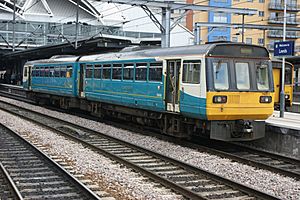
The Class 142 was the biggest Pacer class. It was built by Leyland and BREL in 1985. Its body was also based on a Leyland National bus. Many parts from the Leyland National bus were used. These new trains could carry more passengers: 120 people per two-car train. They used the same engines as earlier Pacers.
The first Class 142 trains were used in Devon and Cornwall. They also ran on local services in the north west. Later, the trains from Cornwall moved to Liverpool and the north east. So, Class 142s were often seen across northern England.
In the early 1990s, the 142s got stronger Cummins engines. This gave them more power. Some trains were then changed for use on the Merseyrail City Line in Liverpool. They got new route signs, better seats, and Merseyrail paint.
When train services became private, Class 142s were used by many companies. These included Arriva Trains Northern, First North Western, Northern Rail, and Transport for Wales. Some were even loaned to First Great Western for a few years.
Class 143 and Class 144: Different Bodies
Around the same time as the Class 142, another Pacer was designed. This one was built by Hunslet-Barclay and used a Walter Alexander bus body. It was called the Class 143 and started running in 1985. Its engines gave it a top speed of 75 miles per hour (121 km/h). This Pacer could carry 122 passengers.
Class 143s were first used in the North East. Then they moved to Wales and the South West. They were used by companies like Valley Lines and Transport for Wales. In 2000, their insides were completely changed. They got new, more comfortable seats. This reduced the number of seats to 106 per train.
Then came the Class 144 in 1987. This also used a Walter Alexander body but on a BREL frame. A Class 144 could be a two-car train with 122 seats or a three-car train with 195 seats. Its top speed was also 75 miles per hour (121 km/h). These trains were used in the North East and are now with Northern Trains.
Good and Bad Points of Pacers
Disadvantages: The Bumpy Ride
People often said Pacers were not very good quality. Instead of the usual bogies (wheel sets), Pacers used a simple four-wheel frame. This often made the ride noisy and less comfortable than other trains. You could hear a loud squealing sound on tight curves.
Without bogies, the suspension was worse. This made the ride bumpier. Pacers were even nicknamed "nodding donkeys" because they bounced up and down on uneven tracks. The basic bench seats could also be uncomfortable. The early trains, especially the Class 141s, often broke down.
Pacers were only used in certain parts of northern and south-west England and south Wales. They were not used in richer areas like London. This made some people feel unfairness.
There were also safety concerns after a crash in 1999. A Pacer train was hit by another train near Winsford. The Pacer's body broke away from its frame. The train was badly damaged. Twenty-seven people were hurt on the other train, but the Pacer was empty.
Advantages: A Cheap Solution
On the other hand, Pacers were a good solution when money was tight. They probably kept train services running on some countryside lines. These lines might not have had any trains if only more expensive ones were available. Pacers were also cheap to run. They could travel 10 miles on one gallon of fuel.
New Trains Replacing Pacers
By 2020, the oldest Pacers were almost 35 years old. All were planned to be removed because they didn't meet new rules for disabled access.
CAF Civity Trains
In July 2019, new Class 195 CAF Civity trains started running on some routes. Because of this, older, upgraded Sprinter trains became available. These Sprinters are now used to replace Pacers.
Vivarail D-Train: Recycled Trains
These new trains are made from old London Underground D78 Stock trains. These were used on the District line until 2017. To make them work on main railway lines, their aluminum bodies, motors, and wheel sets are reused. New diesel engines and interiors are added.
Vivarail showed these D-Trains to train companies. Transport for Wales will use a mix of D-Trains and other trains to replace its Pacers. Other companies have also ordered D-Trains to replace their old trains.
"144e Evolution": A Modernized Pacer
Porterbrook, which owns some Pacer trains, upgraded one Class 144 train in 2014. It was called the "144e Evolution" unit. This train was made to follow the new rules for disabled access. However, no other Pacer trains were upgraded to this standard.
Where Are Pacers Now?
Several Pacers have been saved and are used on heritage railways. The National Railway Museum has preserved one, 142001.
In May 2019, the government asked people for ideas on what to do with the old Pacer trains. Some suggestions included using them as village halls or cafes.



